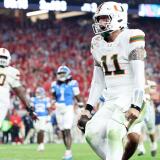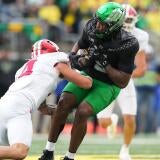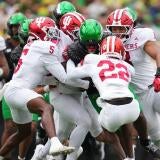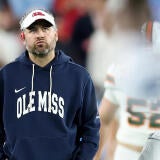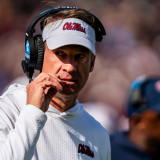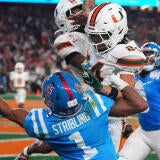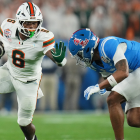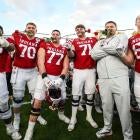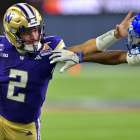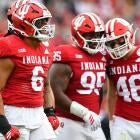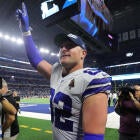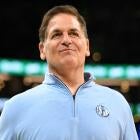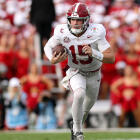Kedon Slovis, Ja'Marr Chase among best dark-horse candidates to win the 2020 Heisman Trophy
The players expected to win the Heisman every spring rarely do
When 2019 Heisman Trophy odds were first posted last spring, you couldn't even find a number on LSU quarterback Joe Burrow at most places. By the time he did show up on odds sheets in June, he was at +15000. That means, for every $1 you'd have bet on Burrow to win the Heisman, you'd have won $150.
Kyler Murray had a similar story in 2018. He wasn't listed on odds sheets that spring, either. Even though Baker Mayfield had just won the Heisman in 2017, not many thought Murray would follow in his footsteps. Hell, most people thought he'd be playing baseball as he'd go on to be a top-10 pick in that summer's MLB Draft. It wasn't until the end of July that Murray showed up on boards with the odds set at +2250. Not the same longshot Burrow was, but a longshot all the same.
Nobody thought Lamar Jackson would win the award in 2016, or that freshmen like Johnny Manziel and Jameis Winston would win it in 2012 and 2013, respectively.
The point is that it's hard to predict who will win the Heisman Trophy months before the season begins. Ohio State QB Justin Fields (+350) and Clemson QB Trevor Lawrence (+400) are the favorites right now, but they aren't competing solely against one another and their competition, but also these extremely high expectations.
Meanwhile, there are names out there most people aren't considering who could sneak up and win the Heisman out of "nowhere." Today, I'm going to try and find them. I've scrolled through the odds at William Hill Sportsbook in search of darkhorses. Candidates with odds of +2500 or higher. These aren't players who are likely to win the Heisman but have a better shot than their odds suggest.
They're the players you want to put a little on now so you can say "I told you so" later.
Kedon Slovis, QB, USC +4000
In April, I wrote about USC being a bit of a darkhorse as a team, and Slovis was a big reason. If USC does win the Pac-12 and flirt with a College Football Playoff berth, Slovis having a big season will come with it, and a glance at past Heisman winners shows how much voters like USC QBs.
As for Slovis himself, if we look at his numbers last season, he had a fantastic year for a freshman who didn't begin the season as the starter. He finished with 3,502 yards passing, 30 touchdowns and nine interceptions in 12 games. His passer efficiency rating of 167.65 ranked seventh nationally.
Other analytics point to Slovis being even better than those numbers suggest. Slovis ranked third nationally among qualified QBs with a 71.9% completion rate behind just LSU's Joe Burrow (76.3%) and Utah's Tyler Huntley (73.1%). But Slovis was a bit better than that.
Using Sports Info Solutions' on-target rate (basically any pass that was catchable and where it was designed to be, completed or not), Slovis had an OT-rate of 81.6%. That finished fourth behind Burrow (87.3%!!), Huntley (83.7%), and Tua Tagovailoa (82.1%). Those numbers don't tell the whole story, though. You see, while Slovis was fourth in OT-rate, he was throwing deeper passes. If we look at air yards (the amount of yards a pass travels past the line of scrimmage) per pass attempt, Burrow is the only one of the three QBs ahead of him.
| Quarterback | Completion % | On-Target % | Air Yards per Attempt |
|---|---|---|---|
Joe Burrow | 76.3 | 87.3 | 5.84 |
Kedon Slovis | 71.9 | 81.6 | 5.02 |
Tyler Huntley | 73.1 | 83.7 | 4.83 |
Tua Tagovailoa | 71.4 | 82.1 | 4.34 |
It's more difficult to maintain accuracy the further you throw the football, but that didn't impact Slovis' performance. Heading into his sophomore season as the starter, with plenty of talent around him, and in an offense designed to let its QB shine, Slovis is an excellent darkhorse candidate to win the trophy.
Dylan McCaffrey, QB, Michigan +7500
We don't know who Michigan's starting QB is going to be in 2020. All we know is that Shea Patterson is gone, and Dylan McCaffrey and Joe Milton are competing to take his place. Based on Heisman odds, it seems sportsbooks are putting their money on it being McCaffrey. I'm approaching this from the standpoint of the darkhorse being "Michigan QB," whether that's McCaffrey or Milton.
Like LSU, Michigan broke in a new offense last season. One meant to spread things out and modernize an attack that had grown a bit obsolete. Unlike LSU, Michigan's offense didn't hit the ground running, mostly because it didn't have a Joe Burrow leading the way. Odds are neither McCaffrey or Milton are Burrow, either, but heading into the second season of a new offense -- one that improved in the second half of last season -- I expect Michigan to be better on that side of the ball.
I also expect Wolverine receivers not to drop so many passes.
Michigan's receiving corps had a drop rate of 12.6% last season. That ranked 121st nationally. Even worse, Michigan receivers had an on-target catch rate of 75.2% last year, according to Sports Info Solutions. That ranked 129th nationally, with only Buffalo being worse at 73.5%.
This tells me two things. One is that Patterson was better than you thought. His on-target rate last season of 75.2% wasn't elite, but did rank No. 32 in the country. It was also a full 19% higher than his 56.2% completion rate. The second is that it will be hard for Michigan receivers to be worse in 2020.
Michigan's two leading receivers last season, Ronnie Bell and Nico Collins, were two of its biggest culprits. Bell dropped 16.9% of his targets and had an on-target catch rate of 70.8%. Collins wasn't much better, checking in with a drop rate of 11.1% and an on-target catch rate of 68.5%.
Here's how they fared compared to the 119 Power Five players to receive at least 60 targets last season.
| Receiver | Drop Rate | P5 Rank (of 119) | On-Target Catch Rate | P5 Rank (of 119) |
|---|---|---|---|---|
Ronnie Bell | 16.9% | 116th | 70.8% | 116th |
Nico Collins | 11.1% | 101st | 68.5% | 117th |
Those two need to be better in 2020. A lot better. There's no guarantee this will happen, but if they do improve, and perhaps get a little luckier, their numbers should rebound. If they do, that will go a long way toward helping McCaffrey or Milton as Michigan's QB.
Ja'Marr Chase, WR, LSU +10000
Derrick Henry is the last running back to win a Heisman in 2015. He was the first RB to win since another Alabama back, Mark Ingram, had done so in 2009. The Heisman has become a QB award for the most part, which is understandable considering how offensive football has changed at the college level.
And that change is why I think a wide receiver will win a Heisman before the next running back does. Desmond Howard and Tim Brown are the only receivers to win the award, and they won them thanks in large part to their productivity as all-purpose players. In 1987, Brown had more return yards (857) than he did receiving yards (846) and the same number of touchdowns (3). The next wide receiver to win the award won't need to be as versatile.
Chase didn't return a single kick or punt last season. As a rusher, he had only one carry for five yards. What he did do, though, was make a lot of big plays in the LSU offense while re-writing the school's record book. Justin Jefferson may have caught more passes, but Chase finished with 1,780 yards and 20 touchdowns. Both led the team, and the touchdowns were a new single-season record in Baton Rouge.
Chase also averaged 21.2 yards per reception. Only Oklahoma's CeeDee Lamb averaged more at 21.4, but Chase proved to be more efficient overall. If we break it down to yards per target, among FBS receivers with at least 10 targets last year, Chase's 14.35 YPT was the best in the country, edging Lamb's 14.27. Let's compare Chase's numbers to the other two top returning SEC receivers last season.
| Receiver | Yards Per Target | Drop Rate | On-Target Catch Rate | 1st Down Rate |
|---|---|---|---|---|
Ja'Marr Chase | 14.35 | 5.8% | 80.8% | 77.4% |
DeVonta Smith | 14.15 | 2.6% | 88.2% | 64.2% |
Jaylen Waddle | 13.80 | 7.9% | 86.8% | 57.6% |
DeVonta Smith has the edge in drop rate and catching passes, and was somebody else I considered for this list, but there's one major problem: there aren't any Heisman odds listed for Smith. Waddle can be found at the same odds as Chase, however, and given his special teams contributions, he's not a bad bet.
As for Chase, while Burrow is gone, and that matters, he'll be the focal point of the passing attack in 2020. He's the clear-cut No. 1 option in an offense that will have the same plan of attack in 2020, even if it doesn't have the same results. That means Chase is likely to put up numbers yet again, which will keep him in the Heisman conversation.
Tanner Morgan, QB, Minnesota +12500
In my early 2021 NFL Mock Draft, I had Minnesota's QB going in the first round. It was a decision I knew would raise a lot of eyebrows, and it did. I assure you, there was a reason for doing it.
Morgan had a great season last year. Fields and Burrow finished second and third respectively among qualified FBS QBs in air yards per pass attempt last season. Fields averaged 6.20 per attempt, while Burrow, as mentioned earlier, was at 5.84. Well, the guy who was ahead of them both was Morgan, and he blew them out of the water.
Morgan averaged 6.72 air yards; a full 0.52 yards more than Fields. That's a considerable margin. What makes it more impressive is that Morgan did so while maintaining an on-target rate of 78.3%, which ranked 11th in the country. Fields ranked 18th at 77.4%, while demigod Burrow finished first (he won the Heisman and went first in the draft for a reason).
Oh, and here's a terrifying thought: Morgan's numbers could have been better. As a team, the Gophers had an on-target catch rate of 83.8%, which ranked 73rd nationally. The team's drop rate of 6.7% ranked tied for 26th. This implies that his receivers had good hands, but whether it was good pass defense or the sun being in somebody's eyes, they missed a lot of catchable passes.
Well, what if they don't miss so many in 2020? Then what becomes of Morgan's numbers?
Also, while the team's leading receiver, Tyler Johnson, has moved onto the NFL, its big-play threat is back. Rashod Bateman averaged 12.44 yards per target and 20.3 yards per reception last season. Both of those numbers were the best in the Big Ten among receivers with at least 20 targets.
Rondale Moore, WR, Purdue +15000
We stick in the Big Ten West for another one of my favorite players. Moore played in only four games last season due to injury, but he was quite productive when healthy. He finished with 29 receptions for 387 yards and two touchdowns, averaging 13.3 yards per reception. While Moore isn't the big-play threat as far as going deep, it's not because he can't -- trust me, he can! -- it's that Purdue's offense simply doesn't operate that way.
What he is, however, is a monster once the ball is in his hands. You know how you always hear coaches saying things like, "we want to get him the ball in space?" Well, Moore is the personification of that. He averaged 7.2 yards after the catch last season. He's also the kind of player that is used in other ways. In 2018, Moore had 744 return yards and 213 yards rushing. We didn't get a chance to see him utilized that way often before going down with an injury, but given the electricity he brings any time he touches the ball, the odds are good we'll see a return to it in 2020.
Moore wasn't the only member of the Purdue offense to go down with an injury last year, as the team cycled through QB after QB. With more consistency at the position in 2020, Moore should be poised to improve on all the promise he showed as a freshman. He will also line up across from David Bell (86 receptions, 1,038 yards, seven touchdowns last year), and these two could comprise the most impressive twosome at receiver in the Big Ten. So defenses won't be allowed to key on Moore.
Plus, Purdue's defense isn't great! That means the Boilermakers will likely need to score a lot of points to win games, and Moore is their best avenue for doing that. They'll also need to win games because that always helps, but let's not forget that Lamar Jackson won the Heisman on a Louisville team that finished 9-4. So it's doable.
The Field
As I said at the top of this post, guys like Burrow and Murray didn't have odds available on them the spring before they won the Heisman. So, if your book will allow you to place a bet on The Field, I wouldn't advise against it.


